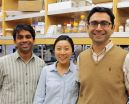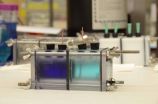(Press-News.org) HOUSTON - (Dec. 3, 2014) - A novel mechanism - similar to how normal tissue stem cells respond to wounding - might explain why bladder cancer stem cells actively contribute to chemo-resistance after multiple cycles of chemotherapy drug treatment. Targeting this "wound response" of cancer stem cells can potentially provide a novel approach for therapeutic invention, said researchers from the National Cancer Institute-designated Dan L. Duncan Cancer Center at Baylor College of Medicine.
The results of their study appear online in the journal Nature today.
"Treatment for advanced bladder cancer is limited to surgery and chemotherapy. There are no targeted treatments available," said Dr. Keith Syson Chan, an assistant professor of molecular and cellular biology and of urology and the corresponding author on the report. "The chemotherapy response is far from ideal so the clinical goal is to advance research into this area and uncover a much more targeted approach."
Together with co-lead authors Antonina Kurtova, a graduate student in the Translational Biology and Molecular Medicine Program at Baylor, and Dr. Jing Xiao, research assistant in urology at Baylor, Chan and his team sought out to identify mechanisms underlying the development of resistance in bladder cancer that has invaded the muscles. They found that regrowth of cancer stem cells actively contributes to therapy resistance between drug treatment cycles.
"This is a paradoxical mechanism leading to resistance, one we didn't expect," said Chan. "The cancer stem cells actively regrow and respond to the induced damage or apoptosis (cell death) caused by chemotherapy in between the different cycles, similar to how normal tissue stem cells respond to wound-induced damages."
The proliferation is stimulated by the release of a metabolite (or factor) called prostaglandin E2 or PGE2 from the dying cells, which causes the cancer stem cells to repopulate tumors that were reduced in size by chemotherapy, they found.
In normal cells, this is a part of the wound repair process when PGE2 induces tissues stem cells to regrow; in cancer PGE2 ironically induces regrowth of more cancer stem cells in between chemotherapy cycles, Kurtova and Xiao said.
Chan said it is important to note that chemotherapy is administered in multiple cycles, which actually evokes the surprising finding.
"Chemotherapy is applied in one cycle then stopped to allow your bone marrow and normal stem cells to recover from the damage, and then another cycle starts again," he said. "The cancer stem cells are also recovering during this gap period, induced by PGE2 released from dying cancer cells
"What would happen if you block PGE2?" the researchers asked.
In studies conducted in mice, the team found that blocking PGE2 abolished the induction of "wound-response" that fuels the regrowth of the cancer stem cells.
In one mouse experiment using tumors extracted from a human patient who previously failed chemotherapy, the team observed an enhanced therapeutic response.
"Importantly, we were able to use a drug already approved by the U.S. Food and Drug Administration," said Kurtova. "This should help us quickly speed up time to start of human clinical trials."
That drug was Celecoxib or Celebrex®, a drug most commonly used as a treatment for arthritis.
Further study in clinical trials is necessary, but the study provides a promising new find in a type of cancer with no current targeted options, Chan said. Importantly, this treatment may be applicable to other types of solid cancers, he said.
INFORMATION:
Additional authors on the report include Qianxing Mo; Senthil Pazhanisamy; Ross Krasnow; Seth P Lerner; Fengju Chen; Terrence Roh; Erica Lay and Philip Levy Ho, all of Baylor.
Funding for this work was supported by the National Cancer Institute (CA129640, CA175397): V Foundation for Cancer Research Scholar Award; Dan L. Duncan Career Award; Bladder Cancer Partnership; Cancer Prevention and Research Institute of Texas (RP101499, RP140102); American Urological Association Research Scholar Award (P.L.H.)
The work was also supported by the Genomic & RNA Profiling Core, Cytometry & Cell Sorting Core and Human Tissue Acquisition & Pathology Core at Baylor, and the Texas Advanced Computing Center at the University of Texas at Austin and Rice University resources.
LA JOLLA, CA--December 3, 2014--A team led by biologists at The Scripps Research Institute (TSRI) has solved a long-standing mystery in neuroscience by identifying the "mechanoreceptor" protein that mediates the sense of touch in mammals.
Mice that lack the Piezo2 ion-channel protein in their skin cells and nerve endings lose nearly all their sensitivity to ordinary light touch, but retain a mostly normal sensitivity to painful mechanical stimuli.
"We can say with certainty that Piezo2 is the principal touch sensor in mammals," said Ardem Patapoutian, professor at TSRI ...
Researchers from the African Genome Variation Project (AGVP) have published the first attempt to comprehensively characterise genetic diversity across Sub-Saharan Africa. The study of the world's most genetically diverse region will provide an invaluable resource for medical researchers and provides insights into population movements over thousands of years of African history. These findings appear in the journal Nature.
"Although many studies have focused on studying genetic risk factors for disease in European populations, this is an understudied area in Africa," says ...
ROSEMONT, Ill.--Compression fractures in the spine due to osteoporosis, a common condition causing progressive bone loss and increased fracture risk, are especially common in older women. A new study appearing in the December 3rd issue of the Journal of Bone & Joint Surgery (JBJS) found that patients who wore a brace as treatment for a spinal compression fracture had comparable outcomes in terms of pain, function and healing when compared to patients who did not wear a brace.
Nearly 700,000 men and women suffer from a spinal compression fracture each year. These fractures, ...
People who work around the clock could actually be setting themselves back, according to Virginia Tech biologists.
Researchers found that a protein responsible for regulating the body's sleep cycle, or circadian rhythm, also protects the body from developing sporadic forms of cancers.
"The protein, known as human period 2, has impaired function in the cell when environmental factors, including sleep cycle disruption, are altered," said Carla Finkielstein, an associate professor of biological sciences in the College of Science, Fralin Life Science Institute affiliate, ...
The more time you spend getting to and from work, the less likely you are to be satisfied with life, says a new Waterloo study.
Published in World Leisure Journal, the research reveals exactly why commuting is such a contentment killer--and surprisingly, traffic isn't the only reason to blame.
"We found that the longer it takes someone to get to work, the lower their satisfaction with life in general," says Margo Hilbrecht, a professor in Applied Health Sciences and the associate director of research for the Canadian Index of Wellbeing.
While commuting has long been ...
Is your inbox burning you out? Then take heart - research from the University of British Columbia suggests that easing up on email checking can help reduce psychological stress.
Some of the study's 124 adults -- including students, financial analysts medical professionals and others -- were instructed to limit checking email to three times daily for a week. Others were told to check email as often as they could (which turned out to be about the same number of times that they normally checked their email prior to the study).
These instructions were then reversed for ...
RIVERSIDE, Calif. - Geckos, found in places with warm climates, have fascinated people for hundreds of years. Scientists have been especially intrigued by these lizards, and have studied a variety of features such as the adhesive toe pads on the underside of gecko feet with which geckos attach to surfaces with remarkable strength.
One unanswered question that has captivated researchers is: Is the strength of this adhesion determined by the gecko or is it somehow intrinsic to the adhesive system? In other words, is this adhesion a result of the entire animal initiating ...
An efficient method to harvest low-grade waste heat as electricity may be possible using reversible ammonia batteries, according to Penn State engineers.
"The use of waste heat for power production would allow additional electricity generation without any added consumption of fossil fuels," said Bruce E. Logan, Evan Pugh Professor and Kappe Professor of Environmental Engineering. "Thermally regenerative batteries are a carbon-neutral way to store and convert waste heat into electricity with potentially lower cost than solid-state devices."
Low-grade waste heat is an ...
New Rochelle, NY, December 3, 2014--Hereditary angioedema (HAE), a rare genetic disease that causes recurrent swelling under the skin and of the mucosal lining of the gastrointestinal tract and upper airway, usually first appears before 20 years of age. A comprehensive review of the therapies currently available to treat HAE in adults shows that some of these treatments are also safe and effective for use in older children and adolescents. Current and potential future therapies are discussed in a Review article in a special issue of Pediatric Allergy, Immunology, and Pulmonology, ...
Typhoon Hagupit continues to intensify as it continued moving through Micronesia on Dec. 3 triggering warnings. NASA's Aqua satellite passed overhead and captured an image of the strengthening storm while the Rapidscat instrument aboard the International Space Station provided information about the storm's winds.
The International Space Station-RapidScat instrument monitors ocean winds to provide essential measurements used in weather predictions, including hurricanes. "RapidScat measures wind speed and direction over the ocean surface and captured an image of Hagupit ...



